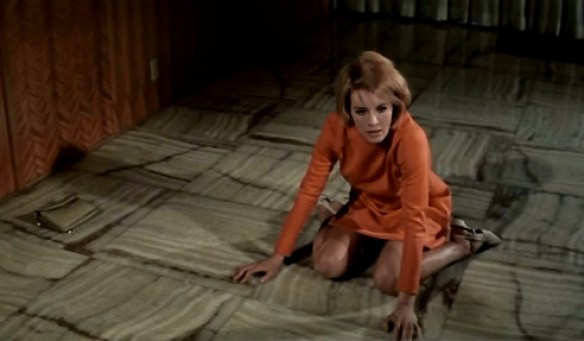2016 TCM Summer Under the Stars Blogathon
 Although it begins and ends on San Francisco’s Alcatraz, Point Blank (1967) is one of the great Los Angeles crime films. Director John Boorman originally planned to shoot the rest of it also in San Francisco but on a scouting trip found it too “pastoral.” (Perhaps he missed the Tenderloin district.) Before the action moves south to LA, we meet Walker (Lee Marvin) and his partner Mal (John Vernon) staging a heist of a gang’s helicopter money drop. Suddenly, Mal pulls a double cross, shoots Walker and makes off with $93,000 and Walker’s wife Lynne (Sharon Acker).
Although it begins and ends on San Francisco’s Alcatraz, Point Blank (1967) is one of the great Los Angeles crime films. Director John Boorman originally planned to shoot the rest of it also in San Francisco but on a scouting trip found it too “pastoral.” (Perhaps he missed the Tenderloin district.) Before the action moves south to LA, we meet Walker (Lee Marvin) and his partner Mal (John Vernon) staging a heist of a gang’s helicopter money drop. Suddenly, Mal pulls a double cross, shoots Walker and makes off with $93,000 and Walker’s wife Lynne (Sharon Acker).
In San Francisco Noir, Nathaniel Rich writes: “Of all the films that have been shot, or set, on Alcatraz, none better captures the Rock’s overwhelming sense of dread and isolation than Point Blank.” Boorman establishes the theme of imprisonment and reinforces it with visual cues throughout the film. Rich notes Boorman’s “hallucinatory, fragmented style.” The British director worked in Hollywood but was greatly influenced by Europeans, especially Michelangelo Antonioni.
Walker’s near murder is so unsettling that one doesn’t question when he not only survives being shot multiple times but makes his way in the frigid waters to San Francisco. Some reviewers have wondered if Walker is a ghost or if the entire film is the fever dream of a dying man. In Detours and Lost Highways: A Map of Neo-Noir, Foster Hirsch writes:
Walker at the start is hurled into a pit of male anxiety. Throughout his quest, he recalls the moment at a party when his accomplice Mal knocked him down and then straddling him seductively whispered, “I need you.” For Walker, the event which he replays in his mind over and over, epitomizes the attack that has been committed against his manhood and suffuses his quest with a lingering homoeroticism that the 1967 film only glancingly acknowledges.
Walker reappears a year later on a tour boat to Alcatraz. It isn’t fully explained what he’s doing there and it seems bizarre that he’d want to revisit the scene of his “murder.” A fellow passenger strikes up a conversation. Yost (Keenan Wynn) insinuates that he’s a cop and he appears to know Walker’s story. He offers to help Walker in his quest, saying he’s after the same people. He supplies Walker with his wife’s address in Los Angeles. 
Myth infuses Boorman’s filmmaking [Excalibur (1981)]. He says in the director’s commentary that Yost is like a character in Arthurian legends. Of course, with an apparition-like character, the protagonist can never be sure if he’s dealing with a trickster or a guardian angel. In It’s a Wonderful Life (1946), all Clarence the angel wants is his wings. Yost may have more sinister motives for helping Walker. Walker himself is a Knight of sorts but unconcerned with gallantry. He’s a ronin, the masterless samurai character Toshiro Mifune, Marvin’s acting partner in Hell in the Pacific (1968)], often played.
Walker lands at LAX. Boorman removed some potted plants but otherwise didn’t change anything in the corridor of the futuristic looking airport. Feet tapping on the soundtrack, Walker strides toward the showdown with his errant wife. With veteran cinematographer Philip Lathrop, Boorman uses the wide-screen image to great advantage. As The Tales of Brave Ulysses blog states: “Beautifully shot with the latest (at that time) 40mm anamorphic Panavision lens, in a carefully engineered colour palette, the non-linear, fragmented narrative achieves often abstract, dream-like qualities and powerful visual images and metaphors.”
With color consultant William Stair, Boorman has a primary color for every major sequence, starting with gray early in the film. By the time Angie Dickinson makes her late entrance as Lynne’s sister, Chris, the color scheme takes on yellows and reds. Hirsch writes that the color scheme “underlines the enigmatic status of the action.” With Lynne out of the picture, it looked as if Walker would be going it alone. Not so fast.
Having a sister, twin or otherwise, show up and take over as the female lead is a device familiar from Psycho (1960) and other movies. Acker is extraordinary as the mysterious Lynne. She brings a vulnerability to the part so even though Lynne might be a duplicitous femme fatale, she’s also sympathetic.
Since there can only be one bad girl per picture, this time Angie is the good girl. Walker uses Chris as bait to trap Mal. She talks tough but one can sense a good heart. There’s a comic slap fight with Marvin that Boorman says she relished because she never forgave Marvin for dangling her out a high-rise window in The Killers (1964). True or not, the scene helps to relieve some of the tension before the “real” violence begins again.
The rustic paradise of the hillside homes of the wealthy where Mal lives contrasts with the hell of the urban flatlands.
At the Los Angeles River, as the bodies start piling up, Walker believes he’ll finally get paid. He then learns that “the Organization” he’s faced off against is just another bureaucracy and its employees don’t carry cash.
Thanks to Kristen of Journeys in Classic Film for hosting the 2016 TCM Summer Under the Stars Blogathon. Click to see all of the entries.







